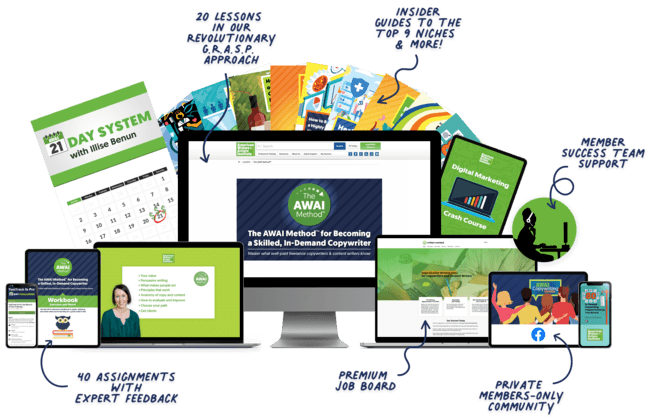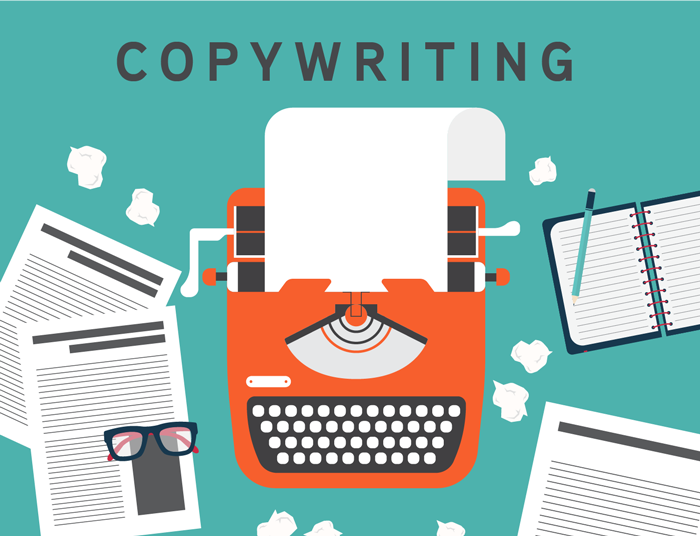
The Basics of Copywriting
What is copywriting, and where does it all begin?
Copywriting has a few core principles that are consistent throughout all types of copy. Mastering these skills will be your ticket to copywriting success.
What follows are the basic fundamentals of copywriting you’ll need to know as a copywriter.
1. Know Your Audience
As a copywriter, who do you think you’re writing for?
It might seem like you’re writing for the companies who pay you, but these aren’t your real audience.
You’re writing for the customers, website visitors, or other people who will be reading your final copy.
Understanding your audience, and how to connect with them, is critical to writing effective marketing materials.
Why should they read your copy? What’s in it for them?
You need to be able to engage a prospective customer or website visitor and show them how a product, service, or website can benefit them.
The best way to do this is by learning everything you can about them.
Many companies you work with as a copywriter will already have some type of profile of their ideal customer. They may call this a buyer profile, or a customer avatar or persona.
A company may also have more than one buyer profile if they market to different demographics of people.
“Learn all you can about people and what makes them tick. You are not in the business of writing words... you are in the business of motivating human beings to take action.” — Mark Everett Johnson, featured in AWAI’s Copywriting Genius: The Master Collection
Each buyer profile will typically include details about the company’s ideal customer, such as their average age, gender, education level, annual income, hobbies and interests, buying habits, as well as common beliefs, such as which political party they support.
By knowing core details like these about a prospective customer or client, you can craft your marketing message and write copy that speaks directly to them.
You’ve likely received marketing materials you’ve immediately dismissed because they’re clearly not relevant to you.
But there’s also a good chance you’ve received a direct-mail package, marketing email, or other promotion that caught your attention.
Why did it catch your attention?
Most likely because you felt it spoke to you in some way. Maybe it offered a product or service you need, a solution to a problem you’re facing, or it was simply entertaining.
This is why the first step of any copywriting project is getting to know exactly who your audience is.
How do you do this, especially if your client doesn’t have a detailed buyer profile? Try some of these steps to get started:
- Visit websites that offer similar products and services to your client. Take note of the type of language they use and topics they cover.
- Read as much marketing material as you can find that targets a similar group of people as your client. Are there any promotions that stand out? Consider what makes them so effective.
- Visit online forums of your target audience and see the issues they discuss and what seems important to them.
- If possible, talk to people in your target audience. Get to know what they’re like and what matters in their lives.
Taking steps like these will help you understand the needs and desires of your target audience, and how your client’s product or service can fulfill those needs.
It will also help you learn the language of your audience, so you can write about what matters to them in a meaningful way.
Copywriting involves elements of persuasion, but it is not about manipulating or deceiving people. It’s about establishing a sincere connection with your prospect, and sharing information that can benefit him or her.
2. Do Your Research
Another fundamental of copywriting is providing extensive proof that your product or service is effective.
This applies to website content writing as well. Unless you’re writing an opinion piece, the majority of blog posts, articles, and other pages are most effective when they’re backed up with supporting facts and proof.
Whatever you’re writing about, always start the process with exhaustive research. You should know the product, service, or topic inside and out before you even start drafting an outline.
Try to answer questions like:
- What are the product’s features and benefits?
- How does it work?
- What will it do for the user?
- What makes the service your client offers better than the competition’s?
- What technical, medical, financial, or similar proof is there to support the claims your client is making about their product or service?
- What scientific research has been done on a topic you’re writing about on a website?
Two good places to start your research are Google’s advanced search page, for general research, and PubMed, for health-related research.
Every field will also have industry-specific sites and directories that can help with your research.
Keep everything you find in one place, whether it’s a paper folder or stored electronically. And don’t delete or remove anything, even if it seems unimportant at the time. When you least expect it, you may find some golden nuggets that will really make your copywriting piece stand out.
Your 9-Step Blueprint to Becoming a Well-Paid Copywriter
Sign up below and get instant access to your FREE 9-step blueprint for making good money as a writer
PLUS receive our FREE daily newsletter, The Writer’s Life, packed with powerful insights, strategies, and expert advice on how to make a great living through writing.
By providing your email today, you’re giving consent for us to contact you by email. We do not sell your personal information to other companies, and you can withdraw consent at any time. By submitting this form, you agree to our Privacy Policy.
3. Understand the 3 Fundamental Rules of Selling
Whether you’re writing sales copy or website content, a solid understanding of the fundamental rules of selling will strengthen whatever you write.
Rule #1: People don’t like the idea of being sold.
Most of us enjoy buying items we want or need, such as a delicious meal, a new cell phone, or maybe a massage.
But no one likes to be sold.
You know the feeling of repulsion you get when a pushy salesperson won’t leave you alone? That’s the feeling you never want to create in a prospect when they read your copy.
Buying feels like you’re in control of the process. Being sold feels like the opposite.
The main way to achieve this is by understanding your prospect, as we discussed above. Make sure you’re speaking their language and talking about what matters to them.
Connect with them first, then you can gently introduce your product or service, focusing on how that product can help them, rather than applying any “high-pressure” sales tactics.
Rule #2: People buy things for emotional, not rational, reasons.
If you want proof of this rule, take the case of chocolate chip cookies.

There’s no logical reason to buy a chocolate chip cookie. It has almost no nutritional value. It’s full of fat and refined sugar, which will both mess up your health. And cookies are expensive, especially gourmet ones that can run over $5 a cookie.
People know all this, but it’s estimated that people buy over 3.5 billion chocolate chip cookies every year in the U.S. alone.
Why do they sell so well if they’re bad for you? Because they make people feel good. Most of us enjoy eating chocolate chip cookies, so we continue to buy them, despite any logical reasons why we shouldn’t.
The lesson here is that effective copywriting needs to appeal to your prospect’s feelings and desires. You need to be able to make your reader want your product or service on an emotional level.
Seven age-old emotional triggers that copywriters often use are:
- Fear
- Greed
- Vanity
- Pride
- Lust
- Envy
- Laziness
But you don’t need to appeal only to negative feelings like these. Positive emotions you can also target include:
- Curiosity
- Optimism
- Altruism
- Love
- Whimsy
- Confidence
- Passion
In addition to understanding your audience in general, you also need to take into account how they will feel when they read your copy.
This rule also applies to leisure activities people choose, including websites they visit and social media posts they read.
If your website is about watercolor painting, and that’s what your prospect is passionate about, it doesn’t matter if rationally they should be reading about world news or another more “serious” topic.
They’re going to visit your website because they love watercolor painting. So, your articles, social media posts, or emails should all be written in a way that matches your audience’s passion.
Rule #3: Once sold, people need to satisfy their emotional decisions with logic.
No one wants to be considered weak or a push-over.
We all want to be in control of our lives and appear like we have it all together.
But eating a chocolate chip cookie is clearly a bad idea because they’re not good for your health. So, to maintain our image of control, we need to logically justify why we’re eating a cookie.
“I’ve had a tough day and deserve a cookie.”
“It was on sale.”
“This brand has added vegetable powder, it’s healthy!”
If we didn’t make these excuses to ourselves, we might feel guilt, shame, or regret because we ate an unhealthy cookie.
“When dealing with people, remember you are not dealing with creatures of logic, but creatures of emotion.” — Dale Carnegie
In a similar way, once a prospect has made an emotional decision that they want your product, copywriters need to provide them with logical, rational reasons why they should buy that product.
Otherwise, your potential customer may not be able to justify the purchase. Or if they do buy, they may feel guilt or regret afterwards, just like eating a cookie without good reason.
This is why most advertising you see will include factual details about a product, like specifications for a new car, nutritional information for a food product, or all the qualifications a personal development coach has.
But all these details are not meant to sell the products. They have little to do with the prospect’s decision to buy, which is made emotionally.
The purpose of providing these details is to make your reader feel good about the emotional decision they have already made.
4. Talk About Benefits, Not Features
Let’s start with a couple of quick definitions…
Features are technical aspects of a product, service, or website. For example, the fact a chair is made of wood, a car wash includes a free shine, or the topic of a website is how to reduce your debt.
On the other hand, benefits are the specific advantages a product, service, or website can offer a prospect. How can that product improve their life?
Copywriting will include the features of whatever you’re writing about, but what you’ll really need to focus on are the benefits.
“The only way to advertise is by not focusing on the product” — Calvin Klein
Benefits tell the reader what’s in it for them. They also create a psychological link between their desires and your product, service, or website.
That psychological link is very important. Ideally, the benefits of your product will stir your reader’s emotional desires and make them want what you’re offering.
For example, a prospect may appreciate the fact a clothing brand uses high-quality, organic cotton. This is a feature of their clothing.
But how the person will look and feel in that clothing is what will make them buy it. Remember, we make most buying decisions based on emotions.
This is a page from REI’s website promoting their current line of outdoor-oriented clothing:

Do you see any mention of the features of their clothing?
There’s not a single fact on this page, only a stirring photo and description of what you can do with their clothing. Which is all suggesting how it will make you feel.
Some other examples of product benefits include:
- An efficient vacuum helps you get the job done in half the time.
- A new golf club will help improve your game.
- A website on growing tomatoes will help you grow a huge crop of delicious tomatoes at home.
- A local Indian restaurant is so authentic you’ll feel like you’re eating in Delhi.
- A marketing course will help increase the sales of your business.
You’re likely starting to see how this applies to any form of copywriting, including content marketing.
People want to read about interesting things that benefit them. Would you like to read an article about how a tomato fertilizer is produced and what it contains? Or would you rather read about how to use a fertilizer and how it’s going to give you lots of delicious tomatoes?
No matter what you’re writing, focusing on the benefits is key to keeping your reader engaged and open to what you’re offering them.
5. Start with a Bang
No area of copywriting gets more attention than headlines and leads.
These are how you catch your reader’s attention. And if you fail, the rest of your writing is pointless.
You’re most likely familiar with headlines, the statements at the top of an advertisement or webpage that are usually in large print.
Writing effective headlines is an art in itself, which we’ll get to in a minute.
But leads can be even more tricky.
A lead is the copy directly after your headline.
The headline is critical for getting your reader’s attention. But once you’ve gotten their attention, the lead must be able to keep them reading.
When you’re crafting headlines, keep in mind that a good headline should accomplish most of the following:
- Set the tone for the entire piece of writing, reflecting the emotions and personal values that will be expressed.
- State exactly what the piece of writing is about. The more specific, the better.
- Include key benefits of the product or service being offered.
- Communicate something of value to the reader.
- Suggest that the written piece contains something unique that the reader has never read before.
You may also want to check out our article on writing winning headlines.
These are some excellent examples of headlines:

You can see each of these headlines are unique and attention-grabbing in their own way. But they also make the topic of what you’re about to read very clear, as well as suggest certain benefits you’ll receive if you continue reading.
For leads, there are many different approaches you can use. Although, in general, we recommend that leads should only take up 10% to 30% of the final copy.
Regardless of how you decide to write a lead, it always needs to do two things:
- Deliver the big promise.
- Introduce the big idea.
The big promise for your project refers to the biggest benefit the product, service, or website can offer your prospect.
And the big idea is just that, a big, thought-provoking idea you present to your prospect that relates to your product or service.
This is the same for both sales and content writing.
In a sales letter, the big promise may be that a new dog-training course can help teach you how to have an obedient, loving dog. That’s a definite benefit.
But the big idea may be that this particular dog training can be easily completed in one weekend. That sort of idea might surprise a reader because dog training is often viewed as a long, painstaking process.
In content writing, the big promise of an article may be that it will tell you how you can fix a zipper. Whereas, the big idea may be that a zipper can easily be fixed at home in a variety of ways without replacing it.
If the lead contains both a big promise and a big idea, you’re well on your way to getting your reader’s attention and drawing them further into your copywriting.
For more in-depth tips and strategies for writing compelling headlines and leads, check out our Writing Great Leads program.
6. Use Clear, Personal Language
Whatever you write, your reader should feel like it’s written just for him.
Copy that feels personal and sincere is far more likely to engage a reader than copy that feels “salesy.”
Claude Hopkins, who wrote the groundbreaking book Scientific Advertising in 1923, once said, “Nobody with a college education should be allowed to write advertising for a mass market.”
What he meant was that sophisticated language has no place in copywriting. Most people aren’t impressed by fancy prose or big words.
Instead, strive to be on the same level as your prospect and use the type of language they would naturally use.
And keep your copy clear and easy to understand, using simple words and sentences whenever possible.
This sales page for the PhotoReading course offered by Learning Strategies is a great example of clear, personable writing:

The writer hasn’t included any complex language, ideas, or facts.
And it’s written in a conversational tone, as if they were writing a letter to a friend.
It also switches between using first person, where the writer refers to himself as “I,” and second person, where he addresses the reader as “you.”
Writing from either first or second person builds a sense of intimacy with the reader. This can also be done writing from third person, as an objective bystander, but first and second person are the most common in copywriting.
7. End with a Call to Action
As the purpose of copywriting is to persuade the reader to take some kind of action, always make this clear at the end of your webpage, sales letter, or other marketing materials.
This is known as a call to action, or CTA. You need to ask the reader to click on a link, schedule a free consultation, make a purchase, or take another form of action.
The most important part of writing a strong call to action is to clearly state exactly what you want your reader to do.
If you want them to schedule an appointment, give them all your contact details and the process they’ll need to go through to get an appointment.
If you want them to read another blog post, provide a few links to other posts that might interest them and invite them to click on one of the links.
Often when your prospect gets to the end of your sales letter, product page, or other document, they’ll start to wonder what’s next. It’s not pushy or aggressive to clearly lay out potential actions your reader can take if they’re interested.
If they’re not interested, they’ll simply move on. But if they are interested, you’re doing them a service by providing details on what they can do next.
It’s also helpful to let them know what will happen after they take action.
When will their order ship?
When will their first email newsletter arrive?
How will they get their bonus products?
Answering questions like these up front will put your prospect at ease, knowing there won’t be any surprises.
Sales materials also tend to include what’s known as a unique selling proposition (USP) towards the end of the document.
The USP is a short summary of why your product or service is unique.
Once your sales piece has gone through all the benefits of the product or service, and backed these up with proof, you can include your USP before you provide the final offer.
The 3 Components of a Good USP
— By Bob Bly, Master Copywriter
- It has to have a direct or implied benefit. It must say “buy this product and you will get this particular benefit.”
- It has to have an important benefit—important enough to “move the masses” (or at least your prospect).
- The benefit must be unique—one that the competition cannot or does not offer.
Summary
Learning the basics of copywriting is an essential first step to becoming a professional copywriter.
And this doesn’t have to take a long time. Many of our members have learned enough copywriting basics in a few months to start landing work in the industry.
One of the fastest ways you can get up to speed on everything you’ll need to know to write outstanding copy is in our Accelerated Program for Six-Figure Copywriting, AWAI’s flagship training program.
The AWAI Method™ for Becoming a Skilled, In-Demand Copywriter

Everything you need to start getting paid to write:
- Hands-on training…
- Assignments with feedback…
- A portfolio of five professional samples…
- Help landing well-paying clients…
- And more!





